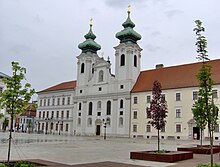Hungarian Benedictine Congregation
The Hungarian Benedictine Congregation (Latin Congregatio Hungarica Ordinis Sancti Benedicti ) is a monastery association of Benedictines .
history
founding
The first Benedictines, Abbot Anastasio and his companions, came to Hungary in 996 , were refugees from Bohemia and were greeted by Prince Géza . King Stephen I , his son, founded the Pannonhalma Abbey . They played an important role in Hungary's conversion to Christianity and provided the country's first bishops.
In 1500 Ludwig II appointed Matteo Tolnai abbot of Pannonhalma in order to renew the monastery. It was mainly based on the Melk reform . He tried to push back the coming system so that every community had a rightful abbot.
The reformed Hungarian monasteries were united in 1514 by Pope Leo X to form a congregation chaired by Tolnai.
Dissolution and restoration
After the defeat of the Hungarians against the Ottoman Empire in the Battle of Mohács in 1526, many monasteries were destroyed and the communities dispersed. In 1585 the Pannonhalma Abbey was occupied and converted into a fortress.
In 1638 the Pannonhalma Abbey was founded by Ferdinand III. restored and tasked with preventing the advance of Protestantism . Benedictine monasticism flourished again after the defeat of the Turks and the reconquest of Hungary. The monks of Pannonhalma succeeded in reviving the old abbeys of Bakonybél , Celldömölk , Tihany and Zalavár, thus restoring the congregation.
There was a close connection between the communities, as all the monks of the congregation completed their novitiate in Pannonhalma and the abbots of the other monasteries were appointed by the Archabbot of Pannonhalma.
During the reign of Joseph II , numerous abbeys and Pannonhalma were dissolved, but were later restored by Francis II . All goods were returned to them with the obligation to keep the secondary school. The task of educating young people encouraged spiritual life, and the Benedictine influence in the country's educated circles grew. Many monks became university professors and members of the Academy of Sciences.
Time of communism
In 1949, after the proclamation of the People's Republic by the Hungarian Working People's Party, all religious orders were dissolved and the Catholic schools closed. The Archabbey of Pannonhalma was spared because of its history and the Benedictines returned in 1950.
Some Benedictines from Hungary founded a priory in São Paulo , Brazil , in 1953 and another in 1958 in the Portola Valley , California . Both monasteries were allowed to accept non-Hungarian novices.
Activities and dissemination
Many abbeys have secondary schools where the monks teach. The monks look after parishes and take on other pastoral activities (management of retreat houses and spiritual exercises).
In addition to Hungary, there are also monasteries in Austria , Brazil and Slovakia . The priory in California was given to the American-Cassinese Benedictine Congregation . The head of the congregation is the Archabbot of Pannonhalma.
In 2008 the congregation had nine abbeys, a priory and 97 monks.
Monasteries
Hungary
- Territorial Abbey of Pannonhalma , 47 monks and 93 oblates
- House in Budapest (1984) 5 monks
- Saint-Maurice de Bakonybél Priory (1032), 4 monks and 7 wafers
- Győr Priory , dependent on Pannonhalma (1803), 12 monks
- Tihany Abbey (1055), priory dependent on Pannonhalma, 8 monks
Austria
- House Unterwart, dependent on Pannonhalma, 3 monks
Slovakia
- House de Komárno (1780), dependent on Pannonhalma, 1 monk
Brazil
- Saint-Gérard de São Paulo Abbey (1953), 11 monks
- Itapecerica da Serra priory (1992), dependent on Saint-Gérard, 6 monks
Individual evidence
- ↑ a b c Ann. Pont. 2010 , p. 1425.
- ↑ a b c G. Békés, DIP, vol. II (1975) col. 1521.
- ↑ G. Békés, DIP, Volume II (1975), Col. 1522.
- ↑ G. Békés, DIP, vol. II (1975) col. 1523.
- ↑ G. Békés, DIP, vol. II (1975), coll. 1522-1523.
literature
- Annuario Pontificio per l'anno 2010 , Libreria Editrice Vaticana, Città del Vaticano 2010. ISBN 978-88-209-8355-0 .
- Guerrino Pelliccia e Giancarlo Rocca (curr.), Dizionario degli Istituti di Perfezione (DIP), 10 full, Edizioni paoline, Milan 1974-2003.
- Asztrik Várszegi : The History of the Hungarian Benedictine Congregation from 1916 to 1996 . In: Erbe und Arbeits , 72 (1996), pp. 5-8.


